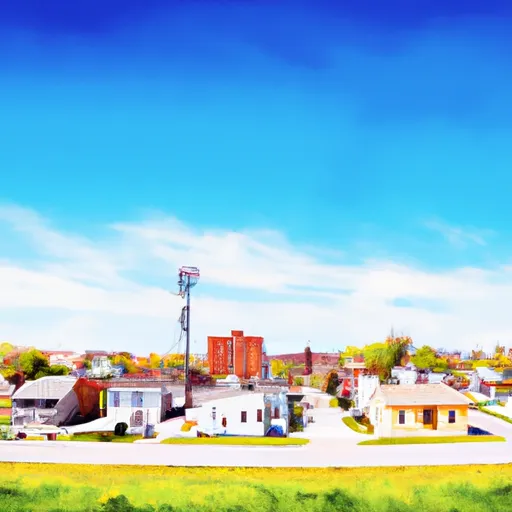-
 Snoflo Premium
Snoflo Premium
Get unlimited access to all our content
With no Ad interruptions! - Start Your Free Trial Login with existing account
Wenona
Eden Index
Climate
7.9
•
Recreation
1.1
•
Community
2.5
•
Safeguard
4.2/10

Wenona, Illinois is a small town located in LaSalle County. The climate in Wenona is classified as humid continental, characterized by warm summers and cold winters. Summers are typically mild, with temperatures ranging from the mid-70s to mid-80s Fahrenheit, while winters are cold with temperatures often dropping below freezing, occasionally reaching the single digits. Precipitation is fairly evenly distributed throughout the year, with average annual rainfall of around 35 inches.
When it comes to hydrology, Wenona is situated near the Vermilion River, which flows through the town. The river provides opportunities for fishing and boating, with common fish species including bass, catfish, and carp. Additionally, Wenona is surrounded by agricultural land, with several small lakes and ponds scattered throughout the area, creating further opportunities for fishing and outdoor activities.
Outdoor recreation opportunities in Wenona include hiking and biking along the nearby Illinois and Michigan Canal State Trail, which follows the route of the historic canal. The trail offers scenic views and a chance to explore the local flora and fauna. The town also has several parks and green spaces for picnicking and enjoying the outdoors. Overall, Wenona offers a picturesque setting for outdoor enthusiasts to engage in various recreational activities.
What is the Eden Index?
The Snoflo Eden Index serves as a comprehensive rating system for regions, evaluating their desirability through a holistic assessment of climate health, outdoor recreation opportunities, and natural disaster risk, acknowledging the profound impact of these factors on livability and well-being.
Climate Health Indicator (CHI): 7.9
Wenona receives approximately
937mm of rain per year,
with humidity levels near 83%
and air temperatures averaging around
11°C.
Wenona has a plant hardyness factor of
5, meaning
plants and agriculture in this region thrive during a short period during spring and early summer. Most
plants will die off during the colder winter months.
By considering the ideal temperature range, reliable water supplies, clean air, and stable seasonal rain or snowpacks, the Climate Health Indicator (CHI) underscores the significance of a healthy climate as the foundation for quality living.
A healthy climate is paramount for ensuring a high quality of life and livability in a region, fostering both physical well-being and environmental harmony. This can be characterized by ideal temperatures, reliable access to water supplies, clean air, and consistent seasonal rain or snowpacks.
Weather Forecast
Streamflow Conditions
Lower Illinois
Area Rivers
Lower Illinois
Snowpack Depths
Lower Illinois
Reservoir Storage Capacity
Lower Illinois
Groundwater Levels
Recreational Opportunity Index (ROI): 1.1
The Recreational Opportunity Index (ROI) recognizes the value of outdoor recreational options, such as parks, hiking trails, camping sites, and fishing spots, while acknowledging that climate plays a pivotal role in ensuring the comfort and consistency of these experiences.
Access to outdoor recreational opportunities, encompassing activities such as parks, hiking, camping, and fishing, is crucial for overall well-being, and the climate plays a pivotal role in enabling and enhancing these experiences, ensuring that individuals can engage in nature-based activities comfortably and consistently.
Camping Areas
| Campground | Campsites | Reservations | Toilets | Showers | Elevation |
|---|---|---|---|---|---|
| Big Biloxi Rec Area | 31 | 50 ft | |||
| Keesler AFB Military | 52 | 22 ft | |||
| Shields RV Military - Gulfport NCB | None | 26 ft | |||
| Moodys Landing | 7 | 135 ft | |||
| Fairley Bridge Landing | 6 | 88 ft | |||
| Cypress Creek Landing | 17 | 103 ft | |||
| Airey Lake | None | 170 ft | |||
| Gulf Marine State Park | None | 6 ft | |||
| Janice Rec.Area | 7 | 116 ft | |||
| Flint Creek Waterpark | 156 | 246 ft |
Nearby Ski Areas
Catastrophe Safeguard Index (CSI):
The Catastrophe Safeguard Index (CSI) recognizes that natural disaster risk, encompassing floods, fires, hurricanes, and tornadoes, can drastically affect safety and the overall appeal of an area.
The level of natural disaster risk in a region significantly affects safety and the overall livability, with climate change amplifying these risks by potentially increasing the frequency and intensity of events like floods, fires, hurricanes, and tornadoes, thereby posing substantial challenges to community resilience and well-being.
Community Resilience Indicator (CRI): 2.5
The Community Resilience Indicator (CRI) recognizes that education, healthcare, and socioeconomics are crucial to the well-being of a region. The CRI acknowledges the profound impact of these elements on residents' overall quality of life. By evaluating educational resources, healthcare accessibility, and economic inclusivity, the index captures the essential aspects that contribute to a thriving community, fostering resident satisfaction, equity, and social cohesion.

